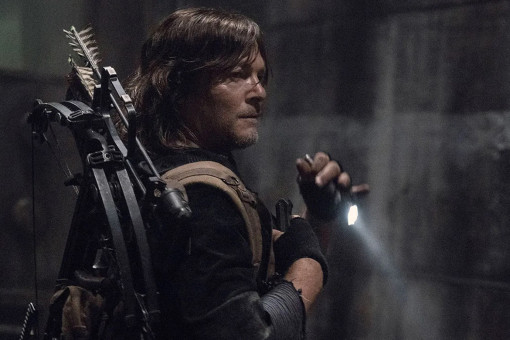For most of television history, horror has played a decidedly supporting role.
The 1950s-1960s anthology series Alfred Hitchcock Presents and The Twilight Zone sometimes presented horror stories.
Sitcoms The Addams Family and The Munsters and soap opera Dark Shadows played horror for laughs and melodrama, respectively. HBO's 1989-1996 anthology Tales from the Crypt began to up the horror ante, but it wasn't until the advent of AMC's post-apocalyptic The Walking Dead in 2010 that the genre really came into its own on television.
"[Producer-director-special effects makeup artist] Greg Nicotero and his team came together to put zombies on high-definition television, which I think totally changed the game, and now it's a paradise if you're a horror fan," said Chris Hardwick, host of the aftershow The Talking Dead. "Horror used to be niche, and niche no longer means small; it just means hyper-focused."
Hardwick's observation came as the moderator of a lively discussion when stars and behind-the-scenes players from The Walking Dead, Netflix's Stranger Things and FX's American Horror Story gathered for the Television Academy program "Hollywood Horror: Scaring Up an Audience for Television," held October 29 at the Saban Media Center in North Hollywood.
Panelists included Walking Dead showrunner Angela Kang and cast members Ryan Hurst and Pollyanna McIntosh; Stranger Things castmates Jake Busey and Cary Elwes; Stranger Things Emmy-winning picture editor Dean Zimmerman, ACE and Emmy-nominated senior visual effects supervisor Paul Graff, a four-time winner for other shows; and American Horror Story Emmy-winning makeup artist Eryn Krueger Mekash and Emmy-nominated composer Mac Quayle, a winner for USA's Mr. Robot.
With series having the potential to run for many years – Walking Dead is in its 10th season – "the onus is on the actor to make a lot of really brave creative choices up front, because you're going to be stuck with them for a long time," Hurst said. He sometimes brings ideas to the producers, some of which, Kang noted, have been used on the show.
The actor's approach to horror differs from those of other genres, McIntosh said, "in that you're probably going to be dealing with things you haven't actually experienced. I haven't eaten a human being. Most of us haven't died. But in acting, you have to be immersed, you have to really believe and you have to really feel.
"And yet, you can't actually go there and be dead. So the stakes are just so high in the storytelling, and there's going to be a lot of stretching of your experience."
Even so, Kang said, "I consider myself a writer of character-driven drama. We happen to be in this horror genre world, but the characters still have to be grounded. We think of villains – they are heroes in their own story. They still are working with an internal drive, and so we have to approach them, and try to understand what made them take a particular philosophy that they have."
Drama was not foremost on Zimmerman's mind when he began editing the first season of Stranger Things. "I had not done a lot of horror. I had done a lot of comedy," he said. Accordingly, he turned an exposition scene into one of comedy, which caught the attention of the series creators.
"The Duffer Brothers were like, 'We need to re-do stuff,'" Zimmerman related.
"They then started interjecting lots of comedy into the horror. That's where for me, the horror genre is that delicate balance between humanism, comedy, real life and then you can always get the scares. To keep the audience at the edge of their seat, you have to let them sit back in order to slap them in the face again. That's what comedy allows you to do."
The scares also come via the makeup and special visual effects. "People expect more," Mekash said. "They want to see the gore, they want to see the blood and a lot of the slashing throats and all the stuff that we do all the time. But we also try and do things that are more creative: beautiful character makeups and monsters when it's called for."
Mekash, who for the just-concluded 1984 ninth season of American Horror Story produced but did not do makeup, said that 75 to 80 percent of the makeup effects are what's known as "practical" – utilizing the makeup artists' skills and tools rather than visual effects; she did work closely with visual effects supervisor Jason Piccioni when necessary.
"A lot of the reward of this show is, it's a puzzle, a constant puzzle of figuring things out: How are we going to do that?"
Along with the scares and storytelling that horror provides, the genre fills another purpose, Kang believes: it reflects viewers' own struggles and triumphs over the metaphorical monsters in their lives.
"As dark as horror can be, I think a lot of times there's something that speaks to grit and the human spirit to survive," she said. "There's something hopeful."












